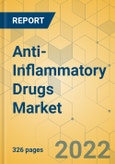Speak directly to the analyst to clarify any post sales queries you may have.
The global anti-inflammatory drugs market is expected to grow at a CAGR of 6.78% during 2022-2027
MARKET GROWTH AND OPPORTUNITIES
- Rising OTC Buying behavior of Anti-inflammatory drugs Among Larger Patient Groups
- Rising Prevalence of a Broad Range of Inflammatory Diseases
- Increasing Use of Biologics for Treating Inflammatory Diseases
GLOBAL ANTI-INFLAMMATORY DRUGS MARKET SHARE AND SEGMENTS
- Based on drug class, biologics and biosimilars is the major contributor in the global anti-inflammatory drugs market, and it is likely to witness high incremental growth of $33.64 billion during the forecast period.
- The global anti-inflammatory drugs market is highly competitive and fragmented even though the leading companies are constantly consolidating their market position through strategic and high-profile mergers and acquisitions.
Segmentation by Drug Class
- Biologics & Biosimilars
- NSAIDs
- Steroids
- Others
Segmentation by Application
- Autoimmune Diseases
- Respiratory Diseases
- Others
Segmentation by Route of Administration
- Parenteral
- Oral
- Topical
- Inhalation
GEOGRAPHICAL ANALYSIS
In 2021, North America was the major revenue contributor and accounted for 41.38% in the global anti-inflammatory drugs market in 2021 and witness the highest incremental growth of $20.88 billion during the forecast period.
Increasing population, the emergence of autoimmune diseases, expansion of demand, increase in pharma and biopharma facilities, and the advent of COVID-19 are major factors to boost the demand for anti-inflammatory drugs in Europe.
Segmentation by Geography
- North America
- US
- Canada
- Europe
- Germany
- France
- UK
- Italy
- Spain
- APAC
- China
- India
- Japan
- Australia
- South Korea
- Latin America
- Brazil
- Mexico
- Argentina
- Middle East & Africa
- South Africa
- Saudi Arabia
- Turkey
VENDOR ANALYSIS
Key Vendors
- AbbVie
- Amgen
- Biogen
- Bristol Myers Squibb
- Eli Lilly & Company
- F. Hoffmann-La Roche
- GlaxoSmithKline
- Johnson & Johnson
- Merck & Co
- Novartis
- Pfizer
Other Prominent Vendors
- Actiza Pharmaceutical
- Allergan
- Antibe Therapeutics
- Aurinia Pharmaceuticals
- AstraZeneca
- Aurobindo Pharma
- Bayer
- Bio-Thera Solutions
- Cadila Pharmaceuticals
- Cipla
- Celltrion
- CENTURION REMEDIES
- Dr. Reddy's Laboratories
- Eisai
- Gilead Sciences
- Glenmark Pharmaceuticals
- Lupin
- Medico Remedies
- Regeneron Pharmaceuticals
- Samsung Bioepis
- Sanofi
- Sun Pharmaceutical Industries
- Swedish Orphan Biovitrum
- UCB
- FUJIFILM KYOWA KIRIN BIOLOGICS
- Teva pharmaceuticals
Table of Contents
Companies Mentioned
- AbbVie
- Amgen
- Biogen
- Bristol Myers Squibb
- Eli Lilly & Company
- F. Hoffmann-La Roche
- GlaxoSmithKline
- Johnson & Johnson
- Merck & Co
- Novartis
- Pfizer
- Actiza Pharmaceutical
- Allergan
- Antibe Therapeutics
- Aurinia Pharmaceuticals
- AstraZeneca
- Aurobindo Pharma
- Bayer
- Bio-Thera Solutions
- Cadila Pharmaceuticals
- Cipla
- Celltrion
- CENTURION REMEDIES
- Dr. Reddy's Laboratories
- Eisai
- Gilead Sciences
- Glenmark Pharmaceuticals
- Lupin
- Medico Remedies
- Regeneron Pharmaceuticals
- Samsung Bioepis
- Sanofi
- Sun Pharmaceutical Industries
- Swedish Orphan Biovitrum
- UCB
- FUJIFILM KYOWA KIRIN BIOLOGICS
- Teva pharmaceuticals
Methodology
Our research comprises a mix of primary and secondary research. The secondary research sources that are typically referred to include, but are not limited to, company websites, annual reports, financial reports, company pipeline charts, broker reports, investor presentations and SEC filings, journals and conferences, internal proprietary databases, news articles, press releases, and webcasts specific to the companies operating in any given market.
Primary research involves email interactions with the industry participants across major geographies. The participants who typically take part in such a process include, but are not limited to, CEOs, VPs, business development managers, market intelligence managers, and national sales managers. We primarily rely on internal research work and internal databases that we have populated over the years. We cross-verify our secondary research findings with the primary respondents participating in the study.

LOADING...








